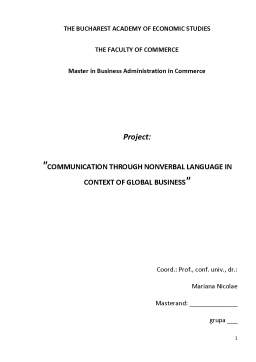Cuprins
- Contents
- Language of time 2
- Language of space 3
- Language of agreement 4
- Language of friendship 4
- Language of religion 5
- Language of superstition 6
- Language of color 6
- Language of gifts 7
- Conclusions 8
- Bibliography
Extras din referat
Outline
People do not always communicate solely through the spoken or written word. Knowingly or not, people routinely communicate with one another in a nonverbal manner. Body language includes movement, appearance, dress, facial expressions, gestures, posture, use of silence, use of touch, timing, distance between speakers and listeners, physical surroundings, tone, and rhythm of speech. Some body language “phrases” (e.g., a smile) are universal, but other phrases vary in meaning across cultural lines. Whereas the Japanese view prolonged eye contact as rude, Americans instead feel that avoidance of eye contact is impolite. In Latino cultures it is also rude to sustain eye contact. In addition, nonverbal cues may vary with a person’s gender and social or economic class. Sitting at a table at an angle signals cooperation and active listening. Sitting straight across from one another, on the other hand, may be perceived as being confrontational. Yet sitting side by side makes conversation awkward.
Beckoning someone with a wave of the hand with palm up is fine in America, but very rude in Japan. Foreigners in Indonesia should also think about local nonverbal communication.
In a popular and often-quoted article, “The Silent Language in Overseas Business,” Edward T. Hall explains that there is a need to appreciate cultural differences in matters concerning the language of time, space, objects, friendship patterns, and agreements. For the purpose of illustration, these languages I listed below.
1. Language of time
Time has different meanings in different countries. An American and an Asian do not mean the same thing when they say, “Why don’t you come over sometime?” In the USA, the statement takes a formal tone, implying that advance notice should be given if the visit is to take place. For an Asian, the meaning is exactly what is said – drop in any time without an appointment, regardless of how early or late it may be in the day.
In Saudi Arabia, a Western-style calendar or daily appointment book is unsuitable as a gift because the 1 January is already halfway into the Islamic year. In Jordan, an Islamic country, the official weekend is on Friday, and the new week begins on Saturday. As a result, the outside world can do business with Jordan and other Muslim countries only on Mondays, Tuesdays, Wednesdays, and half of Thursdays (when most businesses close down early).
In the USA, there is a direct relationship between time and the importance of a matter. When a matter is important, it requires immediate attention and action. In some countries, a reverse relationship exists. A matter of importance requires more time to ponder, and to declare a deadline is to exert undue pressure.
Perceptions of time are culture bound, and three different perceptions may be identified: linear-separable, circular-traditional, and procedural-traditional.
• linear-separable time - time is linear in the sense that it has a past, present, and future. (Most European and North American cultures);
• circular-traditional time - life is supposed to follow a cycle. As a result, the future is seen as the past repeated, and there is no need to plan because time is not valuable;
• procedural-traditional time - the activity or procedure is more relevant than the amount of time spent on it.
Time takes a more “leisurely walk” in many nonWestern societies, whereas Latin American people are usually late, Swedish people are very prompt. But any generalization about punctuality is risky. Asians, for instance, tend not to be punctual, but the Chinese observe strict punctuality for social occasions and appointments. Time may be important to nonWesterners in different ways. Astrologers and monks are frequently consulted in order to determine the proper time for personal and business matters.
Thus in dependence of time perception, the advertise cultures with a nonlinear perception of time appear to provide scattered and symbolic information without explicit conclusion, and to take the form of a drama lecture. In contrast, linear cultures tend to use reasoned arguments, visual information, and a credible source that addresses viewers directly.
2. Language of space
Space has its own special meaning. Its importance is most evident when people converse with one another. When the other party is nearby, such as in the same room, communication is easily facilitated. Difficulty of communicating increases sharply when the distance between the receiver and sender of a message is great (e.g., when one party is across the street, on another floor, or in another room). In such cases, people have to speak loudly or shout in order to be heard, and the other party may still not hear every word, if any words at all. Space also has implications for personal selling. Latin Americans are comfortable with only a few inches of distance between them and repeated embracing. Asians, on the other hand, prefer substantial conversational distance and no physical contact. For Americans, a comfortable distance is something in between these two extremes. An American can give the impression of crowding to an Asian and of running away to a Latin American.
Preview document
Conținut arhivă zip
- Communication Through Nonverbal Language in Context of Global Business.docx

















